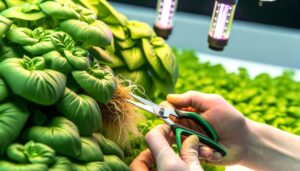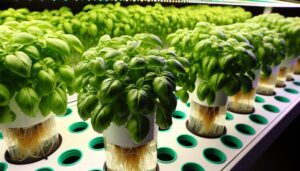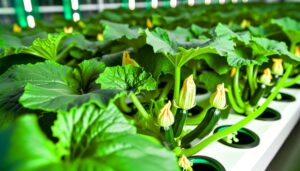Terra Aquatica Vs General Hydroponics
When comparing Terra Aquatica and General Hydroponics, key distinctions emerge in sustainability, nutrient composition, and system compatibility. Terra Aquatica, known for its eco-friendly practices and mineral-based nutrients, excels in creating a balance of organic and high-quality inputs, promoting long-term soil health.
General Hydroponics offers chemically synthesized nutrient solutions with precise N-P-K ratios, designed for consistency and optimized plant growth. While Terra Aquatica's products are praised for their responsiveness and sustainability, General Hydroponics is valued for its user-friendly systems and reliability.
For those pursuing an in-depth evaluation of plant health impacts and financial considerations, further exploration is recommended.
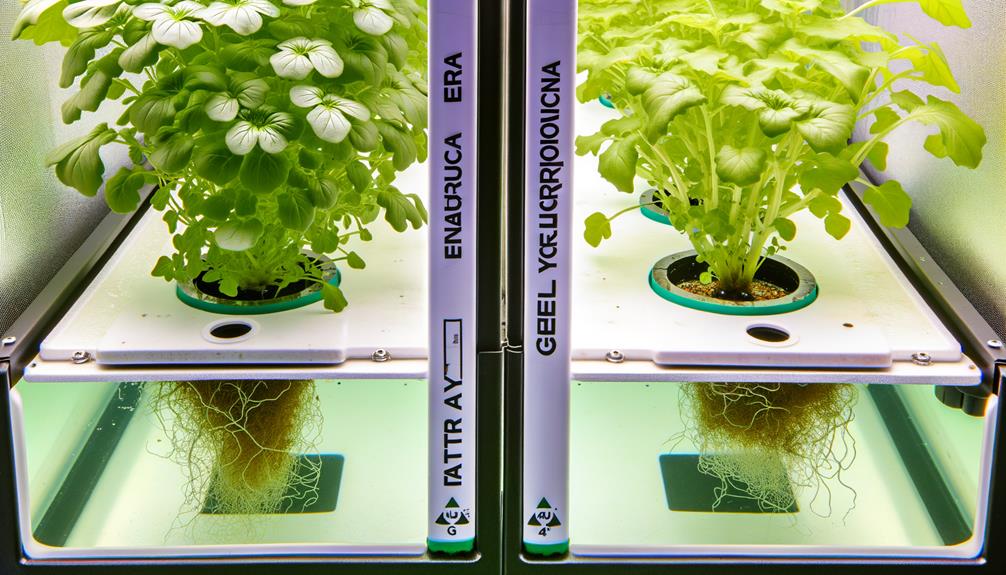
Key Takeaways
- Terra Aquatica focuses on organic and mineral-based nutrients, enhancing plant vigor and sustainability.
- General Hydroponics is renowned for chemically synthesized nutrients with precise N-P-K ratios and long-term stability.
- Terra Aquatica offers eco-friendly packaging and sustainable practices, reducing environmental impact.
- General Hydroponics provides user-friendly, modular systems ideal for both novice and advanced growers.
Company Background

Founded in 1995, Terra Aquatica emerged as a leading innovator in the hydroponics industry, while General Hydroponics, established in 1976, has long been recognized for its pioneering advancements in nutrient solutions and growing systems.
Terra Aquatica has focused on integrating sustainable practices and advanced agronomic research to enhance crop yields and resource efficiency. Conversely, General Hydroponics has built its reputation through rigorous scientific experimentation and development of robust, user-friendly hydroponic systems.
Both companies have greatly contributed to the field, with Terra Aquatica emphasizing eco-friendly methodologies and General Hydroponics prioritizing technological innovation.
Their distinct approaches reflect a thorough understanding of plant physiology and the environmental impacts of modern agriculture, setting industry benchmarks for performance and sustainability.
Product Range
Both Terra Aquatica and General Hydroponics offer an extensive range of products designed to meet the diverse needs of the hydroponics community, from nutrient solutions to advanced cultivation systems.
Terra Aquatica provides a thorough selection of organic and mineral-based nutrients, pH regulation systems, and specialized additives. Their product range includes the TriPart nutrient system, known for its flexibility in various growth stages.
General Hydroponics, on the other hand, is renowned for its Flora Series, a three-part nutrient system praised for its precision and consistency. Additionally, General Hydroponics offers a variety of hydroponic systems such as the WaterFarm and AeroFlo systems, catering to both beginners and advanced growers.
Both companies prioritize innovation and quality assurance in their product lines.
Nutrient Formulation
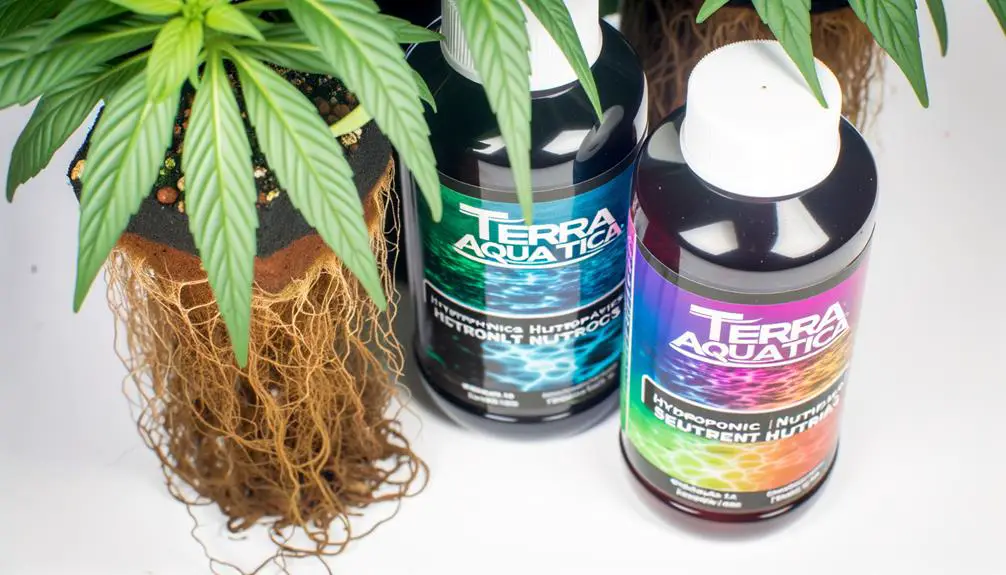
Nutrient formulation is a critical aspect where Terra Aquatica and General Hydroponics exhibit notable differences, particularly in their nutrient composition and formulation consistency.
Terra Aquatica emphasizes organic and mineral-based nutrients, whereas General Hydroponics focuses on a more refined, chemically synthesized nutrient profile.
Analyzing the consistency of these formulations reveals variations in nutrient delivery and stability, impacting plant growth and health outcomes.
Nutrient Composition Differences
When comparing the nutrient formulation of Terra Aquatica and General Hydroponics, it is imperative to analyze the specific ratios and bioavailability of essential macro and micronutrients provided by each brand.
Terra Aquatica emphasizes organic-based nutrients, featuring a higher concentration of naturally-derived elements, which can enhance microbial activity and improve nutrient uptake.
In contrast, General Hydroponics offers a more chemically-oriented formulation, designed for precise control over nutrient availability and concentration. This includes a meticulously balanced N-P-K (Nitrogen-Phosphorus-Potassium) ratio and an extensive range of trace elements such as iron, manganese, and zinc in chelated forms for increased solubility.
Both formulations exhibit distinct advantages depending on the grower's objectives and environmental conditions, thereby necessitating informed selection based on specific cultivation needs.
Formulation Consistency
Maintaining formulation consistency is essential for hydroponic nutrient solutions, ensuring reliable nutrient availability and plant growth outcomes. Terra Aquatica and General Hydroponics both aim for precise nutrient formulations, but their approaches exhibit notable differences.
- Ingredient Sourcing: Terra Aquatica emphasizes organic and sustainable sources, while General Hydroponics often relies on synthetic compounds for consistency.
- Batch Variability: General Hydroponics' advanced manufacturing processes yield minimal batch-to-batch variability, vital for large-scale operations. Terra Aquatica, however, may experience slight variations due to organic ingredient fluctuations.
- Nutrient Stability: General Hydroponics formulations are designed for long-term stability in solution, reducing the risk of nutrient precipitation. Terra Aquatica focuses on maintaining bioavailability, sometimes requiring more frequent adjustments.
Understanding these factors helps growers select the system best suited to their operational needs.
Ease of Use
Both Terra Aquatica and General Hydroponics demonstrate a user-friendly design, yet their ease of use is influenced by specific factors such as system setup, nutrient application, and maintenance requirements.
Terra Aquatica's nutrient solutions are pre-measured, simplifying the preparation process and reducing the likelihood of user error. Additionally, their detailed guides provide clear instructions, beneficial for novice growers.
General Hydroponics offers a modular system setup that allows for easy expansion, which is advantageous for scaling operations. Their nutrient application process is straightforward, supported by extensive, user-friendly documentation.
However, due to more frequent reservoir changes and maintenance checks, General Hydroponics may require slightly more time investment.
System Compatibility
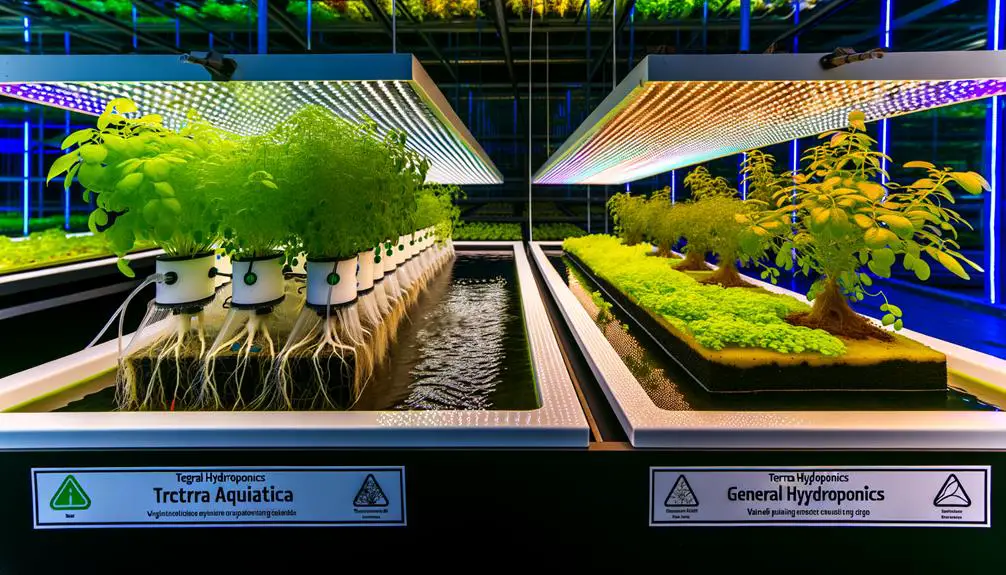
When evaluating system compatibility, it is essential to take into account the adaptability of Terra Aquatica and General Hydroponics to various nutrient delivery systems and hydroponic setups.
Terra Aquatica products are renowned for their versatility across multiple hydroponic configurations, such as NFT, DWC, and drip systems.
In comparison, General Hydroponics offers a robust range of solutions designed to seamlessly integrate with both traditional and advanced hydroponic systems, ensuring ideal nutrient uptake and plant growth.
Nutrient Delivery Systems
The compatibility of nutrient delivery systems between Terra Aquatica and General Hydroponics hinges on several critical factors, including the specific hydroponic setups employed and the chemical composition of the nutrient solutions.
Both brands offer versatile nutrient solutions that cater to various hydroponic systems, but their efficacy can vary based on the following:
- pH Stability: Terra Aquatica tends to have more stable pH levels, which can be beneficial for systems requiring minimal pH adjustments.
- Nutrient Absorption: General Hydroponics provides a faster nutrient uptake, making it ideal for high-demand growth phases.
- System Compatibility: Terra Aquatica solutions are often more compatible with recirculating systems, while General Hydroponics is favored for drip and aeroponic systems.
Understanding these factors is critical for optimizing plant health and growth.
Hydroponic Setup Flexibility
Hydroponic setup flexibility is greatly influenced by the specific design and operational requirements of the chosen nutrient solutions.
Terra Aquatica and General Hydroponics offer distinct advantages in various system configurations. Terra Aquatica's nutrient solutions are formulated to accommodate a wide range of pH levels, making them highly adaptable to diverse hydroponic systems such as deep water culture (DWC), nutrient film technique (NFT), and aeroponics.
Conversely, General Hydroponics provides a modular nutrient system, like the Flora Series, which can be fine-tuned for specific plant stages and growth environments. This allows seamless integration with ebb and flow, drip irrigation, and wick systems.
Both brands offer robust, versatile options, though the choice hinges on specific system compatibility and grower objectives.
Customer Reviews
Customer reviews provide significant insights into the practical performance and reliability of Terra Aquatica and General Hydroponics products, highlighting user experiences and satisfaction levels.
Detailed analysis of customer feedback reveals several key points:
- Ease of Use: Users frequently commend General Hydroponics for its intuitive product design, which simplifies the hydroponic process for both beginners and experts.
- Plant Health and Yield: Many Terra Aquatica customers report enhanced plant vigor and higher yields, attributing this to the precise nutrient formulations.
- Customer Support: Terra Aquatica is often praised for responsive and knowledgeable customer service, whereas General Hydroponics receives mixed reviews in this area, indicating variability in user support experiences.
These insights underscore the strengths and areas for improvement for both brands, assisting potential buyers in making informed decisions.
Price Comparison
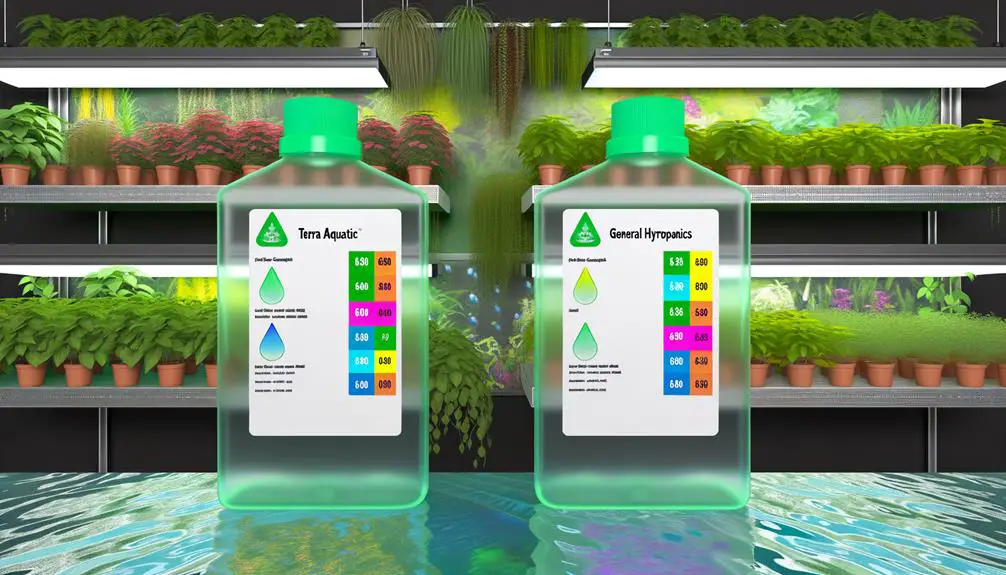
Comparatively evaluating the pricing structures of Terra Aquatica and General Hydroponics reveals critical distinctions that could influence purchasing decisions for both hobbyists and commercial growers. Terra Aquatica offers a competitive pricing model, targeting budget-conscious consumers, whereas General Hydroponics tends to position itself at a higher price point, reflecting its perceived premium quality.
| Product Category | Terra Aquatica Price Range | General Hydroponics Price Range |
|---|---|---|
| Base Nutrients | $15 – $25 | $20 – $35 |
| Additives & Boosters | $10 – $30 | $15 – $40 |
| pH Control Solutions | $8 – $20 | $10 – $25 |
The price differentiation is evident across various product categories, potentially affecting long-term cost efficiency and budget planning for users.
Environmental Impact
Beyond the economic considerations, the environmental impact of products from Terra Aquatica and General Hydroponics presents another significant factor for growers to evaluate.
Detailed analysis reveals key differences in their ecological footprints:
- Production Processes: Terra Aquatica emphasizes sustainable manufacturing practices, reducing carbon emissions and waste. General Hydroponics, while efficient, lacks thorough sustainability metrics.
- Packaging: Terra Aquatica utilizes recyclable and biodegradable materials, whereas General Hydroponics primarily uses conventional plastics, contributing to waste.
- Chemical Composition: Terra Aquatica's formulations are designed to minimize environmental runoff and toxicity, promoting safer disposal and reduced ecological disruption. General Hydroponics, although effective, includes more synthetic additives, which can pose potential environmental risks.
Understanding these factors is essential for making an informed decision based on environmental responsibility.
Final Thoughts
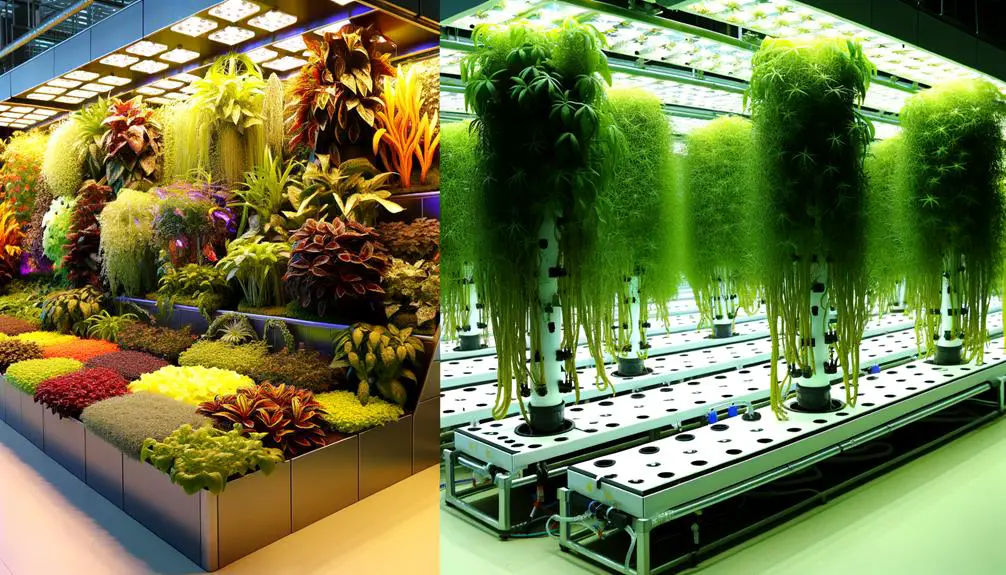
Ultimately, the choice between Terra Aquatica and General Hydroponics hinges on a nuanced evaluation of their economic viability, environmental sustainability, and chemical compositions.
Terra Aquatica, with its emphasis on ecological stewardship, offers formulations that prioritize organic components and biodegradable solutions.
General Hydroponics, known for its robust product line, provides consistent, high-yield results, albeit with a more conventional chemical approach.
Researchers and cultivators must weigh the long-term costs, including potential environmental ramifications and plant health impacts, against immediate financial outlays.
Thorough studies indicate that while Terra Aquatica may present a higher initial investment, its sustainable practices could result in reduced ecological footprints.
Conversely, General Hydroponics may appeal to those prioritizing short-term productivity and lower initial costs.
Conclusion
To sum up, while Terra Aquatica and General Hydroponics both offer diverse product ranges, advanced nutrient formulations, and user-friendly systems, the ultimate irony lies in the similarity of their environmental impact and price points.
Despite claims of uniqueness, their offerings converge in multiple areas, rendering the choice between them less a matter of scientific superiority and more one of brand preference.
Consequently, in the world of hydroponics, distinction often becomes a matter of perception rather than reality.



